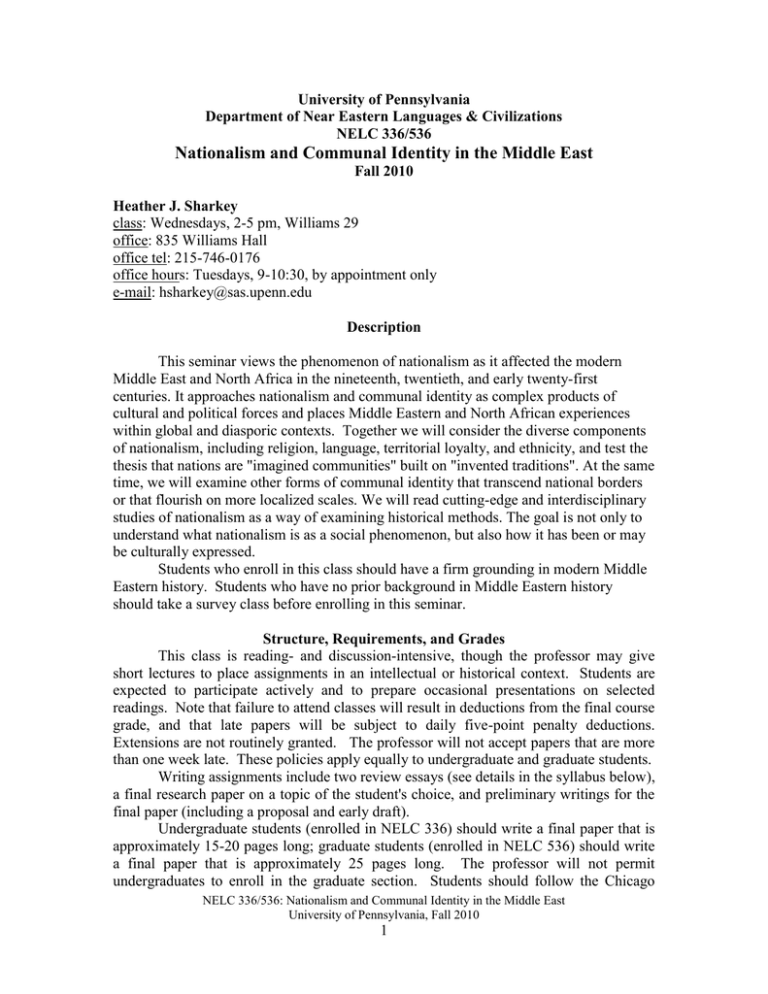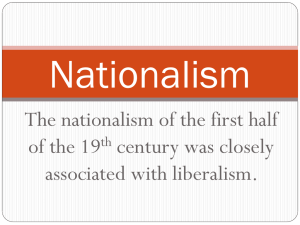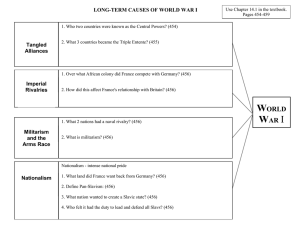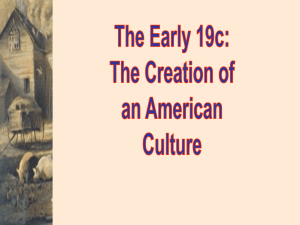Nationalism and Communal Identity in the Middle East
advertisement

University of Pennsylvania Department of Near Eastern Languages & Civilizations NELC 336/536 Nationalism and Communal Identity in the Middle East Fall 2010 Heather J. Sharkey class: Wednesdays, 2-5 pm, Williams 29 office: 835 Williams Hall office tel: 215-746-0176 office hours: Tuesdays, 9-10:30, by appointment only e-mail: hsharkey@sas.upenn.edu Description This seminar views the phenomenon of nationalism as it affected the modern Middle East and North Africa in the nineteenth, twentieth, and early twenty-first centuries. It approaches nationalism and communal identity as complex products of cultural and political forces and places Middle Eastern and North African experiences within global and diasporic contexts. Together we will consider the diverse components of nationalism, including religion, language, territorial loyalty, and ethnicity, and test the thesis that nations are "imagined communities" built on "invented traditions". At the same time, we will examine other forms of communal identity that transcend national borders or that flourish on more localized scales. We will read cutting-edge and interdisciplinary studies of nationalism as a way of examining historical methods. The goal is not only to understand what nationalism is as a social phenomenon, but also how it has been or may be culturally expressed. Students who enroll in this class should have a firm grounding in modern Middle Eastern history. Students who have no prior background in Middle Eastern history should take a survey class before enrolling in this seminar. Structure, Requirements, and Grades This class is reading- and discussion-intensive, though the professor may give short lectures to place assignments in an intellectual or historical context. Students are expected to participate actively and to prepare occasional presentations on selected readings. Note that failure to attend classes will result in deductions from the final course grade, and that late papers will be subject to daily five-point penalty deductions. Extensions are not routinely granted. The professor will not accept papers that are more than one week late. These policies apply equally to undergraduate and graduate students. Writing assignments include two review essays (see details in the syllabus below), a final research paper on a topic of the student's choice, and preliminary writings for the final paper (including a proposal and early draft). Undergraduate students (enrolled in NELC 336) should write a final paper that is approximately 15-20 pages long; graduate students (enrolled in NELC 536) should write a final paper that is approximately 25 pages long. The professor will not permit undergraduates to enroll in the graduate section. Students should follow the Chicago NELC 336/536: Nationalism and Communal Identity in the Middle East University of Pennsylvania, Fall 2010 1 method of citation for bibliographies and footnotes; see The Chicago Manual of Style, 15th edition, for guidelines. Students are also required to make an oral presentation about their final research project. Throughout the semester we will devote time to discussing practical techniques for planning oral presentations; structuring, writing, and revising essays; and conducting independent research. Near the end of the semester we may discuss how students can try to develop their final research papers after the class ends, by seeking publication in journals or (for graduate students especially) by presenting research at professional conferences. Sometime in the semester (date to be announced) we will also meet with librarians in Van Pelt for a special session on research strategies. There will be no final exam. Grades will be calculated as follows: • attendance, participation, and oral presentations: 25% • first review essay (due Sept. 22nd): 20% • second review essay (due Oct. 20th): 20% • paper proposal (due Oct. 27th) and preliminary draft (due Nov. 17h): 10% • final paper (due Dec. 8th): 25% ••• Books and Readings ••• All books, whether used in the class in whole or in part, are in Van Pelt Library’s Rosengarten Reserve. The required texts listed below are available for purchase at the Penn Book Center, 130 South 34th Street (34th & Sansom), Philadelphia. Remaining items (unless otherwise noted) are posted as PDF’s on our Blackboard site. • Anderson, Benedict. Imagined Communities. Revised edition. London: Verso Books, 1991. • Ankori, Gannit. Palestinian Art. London: Reaktion Books, 2006. • Guibernau, Montserrat. The Identity of Nations. Cambridge: Polity, 2007. • Kaplan, Sam. The Pedagogical State: Education and the Politics of National Culture in Post-1980 Turkey. Stanford: Stanford University Press, 2006. • Reid, Donald Malcolm. Whose Pharaohs? Archaeology, Museums, and Egyptian National Identity from Napoleon to World War I (Berkeley: University of California Press, 2002). • Shafir, Gershon & Peled, Yoav. Being Israeli: The Dynamics of Multiple Citizenship. Cambridge: Cambridge University Press, 2002. • Silverstein, Paul. Algeria in France: Transpolitics, Race, and Nation. Bloomington: Indiana University Press, 2004. • Stein, Rebecca L. & Swedenburg, Ted (Eds.). Palestine, Israel, and the Politics of Popular Culture. Durham: Duke University Press, 2005. ~~~~~~~~~~~~~~~~~~~~~~~~~~~~~~~~~~~~~~~~~~~~~~~~~~~~~~~~~~~~~ ••• COURSE PLAN ••• Week 1 – Sept. 8th: What is a Nation? NELC 336/536: Nationalism and Communal Identity in the Middle East University of Pennsylvania, Fall 2010 2 Introduction to the class; group discussion on nationalism. Guiding Questions: How would you define nationalism? Do you have a national identity? What makes a nation? • Film: “Tehran: the 25th Hour” (in “Street Life in Tehran”), dir. Seifollah Samadian (1998), 22 minutes, in Farsi with English subtitles. Week 2 – Sept. 15th: Are Nations Born or Invented? Must Nations Have a Place? • Montserrat Guibernau, The Identity of Nations (Cambridge: Polity, 2007), pp. 1-32. • Ernest Renan, "Qu'est-ce qu'une nation?" (What is a Nation?), in John Hutchinson & Anthony D. Smith (Eds.), Nationalism (Oxford: Oxford University Press, 1994), pp. 17-18. • Eric Hobsbawm, "Inventing Traditions," in Eric Hobsbawm & Terence Ranger (Eds.), The Invention of Tradition (Cambridge: Cambridge University Press, 1983), pp. 1-14. • Hugh Trevor-Roper, "The Invention of Tradition: The Highland Tradition of Scotland," in Hobsbawm & Ranger (Eds.), The Invention of Tradition, pp. 15-41. • Georgia Butina Watson & Ian Bentley, Identity by Design (Amsterdam: Elsevier, 2007), pp. 1-15. In-class: Discussion: How to Write a Book Review Guiding Questions: What do you think of Renan's claim that, "Forgetting, I would even go so far as to say historical error, is a crucial factor in the creation of a nation, which is why progress in historical studies often constitutes a danger for nationalism"? What is the invention of tradition, and how does that process relate to nation(alism)-building? How can national identity be spatially designed, or engineered? Week 3 – Sept. 22nd: Theorizing Nationalism • Benedict Anderson, Imagined Communities: Reflections on the Origin and Spread of Nationalism, pp. 1-46, 83-140. First Review Essay due: In a concise essay of three pages (800 words maximum), discuss and critique Benedict Anderson's theory of nationalism and its origins; be sure to explain his notion of the "imagined community". Week 4 -- Sept. 29th: Nations and Their Pasts • Yael Zerubavel, Recovered Roots: Collective Memory and the Making of Israeli National Tradition (Chicago: The University of Chicago Press, 1995), pp. xiii-xx, 3-36. • Nadia Abu El-Haj, Facts on the Ground: Archaeological Practice and Territorial SelfFashioning in Israeli Society (Chicago: The University of Chicago Press, 2001), pp. 1-44. • Donald Malcolm Reid, Whose Pharaohs? Archaeology, Museums, and Egyptian National Identity from Napoleon to World War I (Berkeley: University of California Press, 2002), pp. 1-62. • Heghnar Zeitlian Watenpaugh, “Museums and the Construction of National History in Syria and Lebanon,” in Nadine Méouchy and Peter Sluglett (Eds.), The British NELC 336/536: Nationalism and Communal Identity in the Middle East University of Pennsylvania, Fall 2010 3 and French Mandates in Comparative Perspectives (Leiden: Brill, 2004), pp. 185-202. Guiding Questions: What role has archaeology played in the construction of Israeli and Egyptian nationalism? What about the role of museums? What role does selection, forgetting, and “selffashioning” play in the invention of national histories and cultures? Week 5 – Oct. 6th: The Nation for Whom? Citizenship and Belonging • Gershon Shafir and Yoav Peled, Being Israeli: The Dynamics of Multiple Citizenship, pp. 1-155, and skim pp. 335-48. • David Miller, Citizenship and National Identity (Cambridge: Polity Press, 2000), pp. 17. • Sandra M. Sufian, Healing the Land and the Nation: Malaria and the Zionist Project in Palestine, 1920-1947 (Chicago: The University of Chicago Press, 2007), pp. 1-19. In-class: Choosing a Final Paper Topic and Planning Your Research. Guiding Questions: David Miller approaches nationalism and citizenship as a political theorist and philosopher; Gershon Shafir and Yoav Peled approach the issue as sociologists. What difference does that make to their approach and conceptualization of the citizenship phenomenon? How exclusive must citizenships be? What are the competing views and philosophies of citizenship that have guided Israeli domestic policies, according to Shafir and Peled, and what practical implications have they had for different kinds of Israelis? Describe the connections that Sandra M. Sufian draws between technology, disease, and nationalism – and between malaria control and Israeli nationalism in particular. FALL BREAK: October 9-12 Week 6 – Oct. 13th: Sports and Popular Nationalism In-Class Film Screenings & Discussion: Goal Dreams, DVD, directed by Maya Sanbar & Jeffrey Saunders (2006), and/or Marathon Beirut: For the Love of Lebanon (2008). Guiding Questions: What is “popular” nationalism, and how do sports fit into the picture? Is it a grassroots phenomenon or is it something that is engineered by the media, by politicians, or others from on high? In-class: Choosing a Final Paper Topic and Planning Your Research Week 7 – Oct. 20th: The Art of Nationalism • Rashid Khalidi, Palestinian Identity: The Construction of Modern National Consciousness (New York: Columbia University Press, 1997), pp. 1-34. • Gannit Ankori, Palestinian Art (London: Reaktion Books, 2006). Second review essay due: In a concise essay of three pages (800 words maximum), discuss and analyze Gannit Ankori’s Palestinian Art. Can art serve as a window into a popular Palestinian nationalism if the creators of the art represent a cultural elite? Is Palestinian art (like other arts) inherently political? NELC 336/536: Nationalism and Communal Identity in the Middle East University of Pennsylvania, Fall 2010 4 Guiding Questions: Rashid Khalidi attempts to discuss the “quintessential Palestinian experience” and to broach the question, “What are the limits of Palestine?” in terms not so much of spatial limits but of the limits of cultural and social imagination. What are the cultural and imaginative dimensions of nationalism? Where do popular and elite nationalism meet? Week 8 – Oct. 27th: Transnationalism • Paul Silverstein, Algeria in France: Transpolitics, Race, and Nation (Bloomington: Indiana University Press, 2004), pp. 1-34, 121-50, 184-212. • Montserrat Guibernau, The Identity of Nations, pp. 58-88. • Betigul Ercan Argun, Turkey in Germany: The Transnational Sphere of Deutschkei (London: Routledge, 2003), Introduction, pp. 3-15, and Chapter 5 (“Between Deutschkei and Turkey”), pp. 65-80. • Eva Østergard-Nielsen, Transnational Politics: Turks and Kurds in Germany (London: Routledge, 2002), Introduction, pp. 1-12, and Chapter 7 (“From ‘Remittance Machines’ to ‘Euro-Turks’”), pp. 107-22. Guiding Questions: What is transnationalism and are there transnational identities? When do immigrant populations become “nativised” and nationalized? (And is that last question even meaningful or appropriate?) What role do German-born people of Turkish family origin, or France-born people of Algerian family origin, play vis-à-vis Turkey-Germany and Algeria-France? Are the borders of nationstates becoming less relevant in an age of transnationalism and globalization? Final Paper Proposal due: This proposal has two parts. (1) Submit a one-page abstract of your final paper topic, describing what you intend to study and what preliminary hypotheses you have. (2) Submit a bibliography listing at least six relevant published books or academic articles – not internet sources. Week 9 – Nov. 3rd: Education and Nation-Building • Sam Kaplan, The Pedagogical State: Education and the Politics of National Culture in Post-1980 Turkey (Stanford: Stanford University Press, 2006), pp. xv-xx, 1-124. • Mandana E. Limbert, “Oman: Cultivating Good Citizens and Religious Virtue,” in Eleanor Abdella Doumato & Gregory Starrett (Eds.), Teaching Islam: Textbooks and Religion in the Middle East (Boulder: Lynne Rienner Publishers, 2007), pp. 103-24. • Michael Slackman, “In Algeria, a Tug of War for Young Minds,” The New York Times, June 23, 2008. (Search for this at the New York Times website: http://www.nytimes.com/) • Alexander Stille, “The Betrayal of History,” The New York Review of Books, Vol. 45, No. 10, June 11, 1998. (Accessible in electronic form by searching by journal title in Franklin, choosing the version in electronic format, entering the journal’s website through Penn’s proxy server, and searching by author or the article’s title.) Guiding Questions: What role do schools play in the construction of nationalisms? How do policy-setters and textbook writers choose histories? In Turkey, how have educators reconciled (or not reconciled) religion in national curricula? What is Ibadism and how does it shape Oman’s culture and educational landscape today? What political factors have influenced policy-setters in Algeria and the U.S.A.? NELC 336/536: Nationalism and Communal Identity in the Middle East University of Pennsylvania, Fall 2010 5 Week 10 – Nov. 10th: The Sound of the Nation • Jonathan Holt Shannon, Among the Jasmine Trees: Music and Modernity in Contemporary Syria (Middletown: Wesleyan University Press, 2006), pp. xv-xxvi, 1-21. • Motti Regev & Edwin Seroussi, Popular Music & National Culture in Israel (Berkeley: University of California Press, 2004), pp. 1-11, and Chapter 6, “’And the Winner Is….: Popular Song Festivals,” pp. 113-33. • Joseph Massad, “Liberating Songs: Palestine Put to Music,” in Stein & Swedenburg (Eds.), Palestine, Israel, and the Politics of Popular Culture, pp. 175-201. • Amy Horowitz, “Dueling Nativities: Zehava Ben Sings Umm Kulthum,” in Stein & Swedenburg (Eds.), Palestine, Israel, and the Politics of Popular Culture, pp. 202-230. Guiding Questions: Jonathan Holt Shannon describes a Syrian social and musical scene in which concern for “Arab authenticity” is paramount. Why may Syrians be preoccupied more with Arab-ness than with Syrian-ness? How does popular music offer windows into the historical and cultural complexities of Israeli society? What did Israel’s decision to join the Euro-Vision song contest do for Israeli popular music and nationalism? According to Massad, what role have songs played in Palestinian nationalist struggles? What did it mean for Israeli popular music to have taken (according to Amy Horowitz) an “eastward shift” in the 1990s? In-class: Sign up for final presentations Week 11 – Nov. 17th: The Look of the Nation • Laleh Khalili, “Virtual Nation: Palestinian Cyberculture in Lebanese Camps,” in Rebecca L. Stein & Ted Swedenburg (Eds.), Palestine, Israel, and the Politics of Popular Culture (Durham: Duke University Press, 2005), pp. 126-49. • Livia Alexander, “Is There a Palestinian Cinema? The National and Transnational in Palestinian Film Production,” in Stein & Swedenburg (Eds.), Palestine, Israel, and the Politics of Popular Culture, pp. 150-74. • Christopher Stone, Popular Culture and Nationalism in Lebanon (London: Routledge, 2008), pp. 1-12. • Nada M. Shabout, Modern Arab Art: Formation of Arab Aesthetics (Gainesville: University Press of Florida, 2007), Preface pp. xiii-xvi, and Introduction (“The Polemics of Modern Arab Art”), pp. 1-10. • Luke Schleusener, “From Blog to Street: The Bahraini Public Sphere in Transition,” Arab Media & Society (2006), http://www.arabmediasociety.com/?article=15 Guiding Questions: What can the internet do for nationalism that other (and earlier) media genres and technologies could not? What does the cinema do for nationalism as well? What, according to Nada M. Shabout, makes art “Arab” (as opposed to Islamic, for example)? How may the idea of “Arab art” (or “Arab music” or “Arab cinema”) relate to Arab nationalism? According to Stone, how did the musical theater at Lebanon’s Baalbek festival privilege a particular vision of Lebanese national culture, and what can this tell us about the “staging” of nationalisms? How, according to Luke Schleusener, is a new blogging culture contributing to the formation of a Bahraini “Shi’a nationalism” and to a Bahraini “national blogosphere”? Preliminary draft due: Submit the introductory section of your paper (approx. two pages). This introduction should provide an overview of your topic, explain the structure of your paper, and point to your general thesis or argument. The introduction is often the NELC 336/536: Nationalism and Communal Identity in the Middle East University of Pennsylvania, Fall 2010 6 most difficult part of a paper to write, so it is critical that you give yourself the opportunity to get early feedback before revision. Week 12 – Nov. 24th: No Class. Use the extra time to work on your research papers. Happy Thanksgiving! Part 4: The Fruits of Research: Case Studies Week 13 – Dec. 1st: Presentations of Research Papers Week 14 – Dec. 8th: Presentations of Research Papers; and Wrapping Up Final papers are due on Wednesday, December 15th. Please submit your final papers in two formats: 1) a paper copy placed in my NELC mailbox; 2) an electronic copy, sent to me no later than 8pm, as a Word file via email. Make sure that your paper follows the Chicago method for citing works. Use either footnotes or endnotes, and include a bibliography. NELC 336/536: Nationalism and Communal Identity in the Middle East University of Pennsylvania, Fall 2010 7

![“The Progress of invention is really a threat [to monarchy]. Whenever](http://s2.studylib.net/store/data/005328855_1-dcf2226918c1b7efad661cb19485529d-300x300.png)



